Enhancing Thermal Performance of Autoclaved Aerated Concrete (AAC) Incorporating Sugar Sediment Waste and Recycled AAC with Phase Change Material-Coated Applications for Sustainable Energy Conservation in Building
Abstract
:1. Introduction
2. Experimental Methodology
2.1. Raw Materials and Fabrication of AAC
2.2. Measurements of Density, Water Absorption, Compressive Strength, Flexural Strength, Thermal Conductivity, and Tobermorite Phase
2.3. Thermal Behavior Analysis and Utilization of Phase Change Material
2.4. Assessing the Thermal Properties of the Modified AAC under Controlled Temperature Conditions
3. Results and Discussion
3.1. Density, Water Absorption, and Thermal Conductivity
3.2. Compressive Strength and Flexural Strength
3.3. Phase Formation and Microstructure of AAC
3.4. Phase Change Material Behavior
3.5. Time Lag and Decrement Factor
4. Conclusions
Author Contributions
Funding
Institutional Review Board Statement
Informed Consent Statement
Data Availability Statement
Acknowledgments
Conflicts of Interest
References
- Ürge-Vorsatz, D.; Cabeza, L.F.; Serrano, S.; Barreneche, C.; Petrichenko, K. Heating and cooling energy trends and drivers in buildings. Renew. Sustain. Energy Rev. 2015, 41, 85–98. [Google Scholar] [CrossRef]
- Adilkhanova, I.; Memon, S.A.; Kim, J.; Sheriyev, A. A novel approach to investigate the thermal comfort of the lightweight relocatable building integrated with PCM in different climates of Kazakhstan during summertime. Energy 2021, 217, 119390. [Google Scholar] [CrossRef]
- Alassaad, F.; Touati, K.; Levacher, D.; Mendili, Y.E.; Sebaibi, N. Improvement of cob thermal inertia by latent heat storage and its implication on energy consumption. Constr. Build. Mater. 2022, 329, 127163. [Google Scholar] [CrossRef]
- Cui, K.; Liang, K.; Chang, J.; Lau, D. Investigation of the macro performance, mechanism, and durability of multiscale steel fiber reinforced low-carbon ecological UHPC. Constr. Build. Mater. 2022, 327, 126921. [Google Scholar] [CrossRef]
- Kumar, D.; Alam, M.; Memon, R.A.; Bhayo, B.A. A critical review for formulation and conceptualization of an ideal building envelope and novel sustainability framework for building applications. Clean. Eng. Technol. 2022, 11, 100555. [Google Scholar] [CrossRef]
- Abbas, H.M.; Jalil, J.M.; Ahmed, S.T. Experimental and numerical investigation of PCM capsules as insulation materials inserted into a hollow brick wall. Energy Build. 2021, 246, 111127. [Google Scholar] [CrossRef]
- Golewski, G.L. The influence of microcrack width on the mechanical parameters in concrete with the addition of fly ash: Consideration of technological and ecological benefits. Constr. Build. Mater. 2019, 197, 849–861. [Google Scholar] [CrossRef]
- Da Cunha, S.R.L.; de Aguiar, J.L.B. Phase change materials and energy efficiency of buildings: A review of knowledge. J. Energy Storage 2020, 27, 101083. [Google Scholar] [CrossRef]
- Pan, J.; Zou, R.; Jin, F. Experimental study on specific heat of concrete at high temperatures and its influence on thermal energy storage. Energies 2017, 10, 33. [Google Scholar] [CrossRef]
- Tao, H.S. Research for Developing Aerated Concrete by Using Fly Ash with High Calcium of Gehua Power Plant in Hongshan; Wuhan University of Technology: Wuhan, China, 2004. [Google Scholar]
- Huang, L.J.; Wang, H.Y.; Wu, Y.W. Properties of the mechanical in controlled low-strength rubber lightweight aggregate concrete (CLSRLC). Constr. Build. Mater. 2016, 112, 1054–1058. [Google Scholar] [CrossRef]
- Wongsa, A.; Zaetang, Y.; Sata, V.; Chindaprasirt, P. Properties of lightweight fly ash geopolymer concrete containing bottom ash as aggregates. Constr. Build. Mater. 2016, 111, 637–643. [Google Scholar] [CrossRef]
- Dulsang, N.; Kasemsiri, P.; Posi, P.; Hiziroglu, S.; Chindaprasirt, P. Characterization of an environment friendly lightweight concrete containing ethyl vinyl acetate waste. Mater. Des. 2016, 96, 350–356. [Google Scholar] [CrossRef]
- Koronthalyova, O. Moisture storage capacity and microstructure of ceramic brick and autoclaved aerated concrete. Constr. Build. Mater. 2011, 25, 879–885. [Google Scholar] [CrossRef]
- Topcu, I.B.; Isıkdag, B. Effect of expanded perlite aggregate on the properties of lightweight concrete. J. Mater. Process. Technol. 2008, 204, 34–38. [Google Scholar] [CrossRef]
- Beskopylny, A.N.; Shcherban’, E.M.; Stel’makh, S.A.; Mailyan, L.R.; Meskhi, B.; Evtushenko, A.; El’shaeva, D.; Chernil’nik, A. Improving the Physical and Mechanical Characteristics of Modified Aerated Concrete by Reinforcing with Plant Fibers. Fibers 2023, 11, 33. [Google Scholar] [CrossRef]
- Thakur, A.; Kumar, S. Mechanical Properties and Development of Light Weight Concrete by Using Autoclaved Aerated Concrete (AAC) with Aluminum Powder. Mater. Today Proc. 2022, 56, 3734–3739. [Google Scholar] [CrossRef]
- Bernard, V.A.R.; Renuka, S.M.; Avudaiappan, S.; Umarani, C.; Amran, M.; Guindos, P.; Fediuk, R.; Ivanovich Vatin, N. Performance Investigation of the Incorporation of Ground Granulated Blast Furnace Slag with Fly Ash in Autoclaved Aerated Concrete. Crystals 2022, 12, 1024. [Google Scholar] [CrossRef]
- Ali, T.; Saand, A.; Bangwar, D.K.; Buller, A.S.; Ahmed, Z. Mechanical and Durability Properties of Aerated Concrete Incorporating Rice Husk Ash (RHA) as Partial Replacement of Cement. Crystals 2021, 11, 604. [Google Scholar] [CrossRef]
- Kumar, M.A.; Prasanna, K.; Chinna Raj, C.; Parthiban, V.; Kulanthaivel, P.; Narasimman, S.; Naveen, V. Bond Strength of Autoclaved Aerated Concrete Manufactured Using Partial Replacement of Flyash with Fibers—A Review. Mater. Today Proc. 2022, 65, 581–589. [Google Scholar] [CrossRef]
- Stepien, A. Analysis of Porous Structure in Autoclaved Materials Modified by Glass Sand. Crystals 2021, 11, 408. [Google Scholar] [CrossRef]
- Soultana, A.; Galetakis, M. Utilization of Quarry Dust and Calcareous Fly Ash for the Production of Lightweight Cellular Micro-Concrete—Synthesis and Characterization. Buildings 2020, 10, 214. [Google Scholar] [CrossRef]
- Matsuno, A.; Kawamoto, K. Assessment of Dispersed Oil Sorption in Oily Wastewater onto Hydrophobized/Oleophilized Autoclaved Aerated Concrete (AAC) Grains. Environments 2023, 10, 92. [Google Scholar] [CrossRef]
- Jasiński, R.; Gąsiorowski, T. Comparative Studies of the Confined Effect of Shear Masonry Walls Made of Autoclaved Aerated Concrete Masonry Units. Materials 2023, 16, 5885. [Google Scholar] [CrossRef]
- Zou, D.; Que, Z.; Cui, W.; Wang, X.; Guo, Y.; Zhang, S. Feasibility of recycling autoclaved aerated concrete waste for partial sand replacement in mortar. J. Build. Eng. 2022, 52, 104481. [Google Scholar] [CrossRef]
- Volk, R.; Steins, J.J.; Stemmermann, P.; Schultmann, F. Comparison of different post-demolition autoclaved aerated concrete (AAC) recycling options. IOP Conf. Ser. Earth Environ. Sci. 2022, 1078, 012074. [Google Scholar] [CrossRef]
- Grzyb, K.; Jasiński, R. Research on the Behavior of Stiffening Walls in Single-Storey Buildings Made of Autoclaved Aerated Concrete (AAC) Masonry Units. Materials 2022, 15, 7404. [Google Scholar] [CrossRef]
- Cui, K.; Lu, D.; Jiang, T.; Zhang, J.; Jiang, Z.; Zhang, G.; Chang, J.; Lau, D. Understanding the role of carbon nanotubes in low carbon sulfoaluminate cement-based composite. J. Clean. Prod. 2023, 416, 137843. [Google Scholar] [CrossRef]
- Cui, K.; Liang, K.; Jiang, T.; Zhang, J.; Lau, D.; Chang, J. Understanding the role of carbon nanotubes in low carbon concrete: From experiment to molecular dynamics. Cem. Concr. Compos. 2023, 142, 105189. [Google Scholar] [CrossRef]
- Ma, B.G.; Zheng, X. Study on a new kind of aerated concrete containing efflorescence sand-phosphorus slag-lime. J. Build. Mater. 1999, 2, 223–228. [Google Scholar]
- Wang, Y.; Yin, J.; Chen, J.C.; Peng, C.Q. Aerocrete made with low silicon tailings of Cheng Chao iron ore mine. J. Wuhan Univ. Technol. Mater. Sci. 2000, 15, 58–62. [Google Scholar]
- Mostafa, N.Y. Influence of air-cooled slag on physicochemical properties of autoclaved aerated concrete. Cem. Concr. Res. 2005, 35, 1349–1357. [Google Scholar] [CrossRef]
- Wang, Q.K.; Chen, Y.Z.; Li, F.X.; Sun, T.; Xu, B.B. Microstructure and properties of silty siliceous crushed stone-lime aerated concrete. J. Wuhan Univ. Technol. Mater. Sci. 2006, 21, 17–20. [Google Scholar]
- Li, F.X.; Chen, Y.Z.; Long, S.Z. Experimental investigation on aerated concrete with addition of lead-zinc tailings. J. Southwest Jiaotong Univ. 2008, 43, 810–815. [Google Scholar]
- Kurama, H.; Topcu, I.B.; Karakurt, C. Properties of the autoclaved aerated concrete produced from coal bottom ash. J. Mater. Process. Technol. 2009, 209, 767–773. [Google Scholar] [CrossRef]
- Huang, X.Y.; Ni, W.; Cui, W.H.; Wang, Z.J.; Zhu, L.P. Preparation of autoclaved aerated concrete using copper tailings and blast furnace slag. Constr. Build. Mater. 2012, 27, 1–5. [Google Scholar] [CrossRef]
- Jitchaiyaphum, K.; Sinsiri, T.; Jaturapitakkul, C.; Chindaprasirt, P. Cellular lightweight concrete containing high-calcium fly ash and natural zeolite. Int. J. Miner. Metal. Mater. 2013, 20, 462–471. [Google Scholar] [CrossRef]
- Thongtha, A.; Maneewan, S.; Punlek, C.; Ungkoon, Y. Investigation of the compressive strength, time lags and decrement factors of AAC-lightweight concrete containing sugar sediment waste. Energy Build. 2014, 84, 516–525. [Google Scholar] [CrossRef]
- Maneewan, S.; Janyoosuk, K.; Hoy-Yen, C.; Thongtha, A. Incorporating black dust into autoclaved aerated concrete wall for heat transfer reduction. J. Met. Mater. Miner. 2019, 29, 82–87. [Google Scholar]
- Mano, C.; Thongtha, A.; Maneewan, S.; Punlek, C. Improvement of the thermal efficiency of autoclaved aerated concrete by black powder. ScienceAsia 2021, 47S, 76–82. [Google Scholar] [CrossRef]
- Kumar, D.; Alam, M.; Sanjayan, J.; Harris, M. Comparative analysis of form-stable phase change material integrated concrete panels for building envelopes. Case Stud. Constr. Mater. 2023, 18, e01737. [Google Scholar] [CrossRef]
- Kumar, D.; Alam, M.; Doshi, A.J. Investigating the influence of thermal conductivity and thermal storage of lightweight concrete panels on the energy and thermal comfort in residential buildings. Buildings 2023, 13, 720. [Google Scholar] [CrossRef]
- Ramakrishnan, S.; Sanjayan, J.; Wang, X. Experimental research on using form-stable PCM-integrated cementitious composite for reducing overheating in buildings. Buildings 2019, 9, 57. [Google Scholar] [CrossRef]
- Liu, X.; Kang, W.; Li, X.; Zeng, L.; Li, Y.; Wang, Q.; Zhang, C. Solid-state mechanochemistry advancing two-dimensional materials for lithium-ion storage applications: A mini review. Nano Mater. Sci. 2023, 5, 210–227. [Google Scholar] [CrossRef]
- Yang, T.; Niu, Y.; Liu, Q.; Xu, M. Cathode host engineering for non-lithium (Na, K, and Mg) sulfur/selenium batteries: A state-of-the-art review. Nano Mater. Sci. 2023, 5, 119–140. [Google Scholar] [CrossRef]
- Wang, H.; Fu, F.; Huang, M.; Feng, Y.; Han, D.; Xi, Y.; Xiong, W.; Yang, D.; Niu, L. Lignin-based materials for electrochemical energy storage devices. Nano Mater. Sci. 2023, 5, 141–160. [Google Scholar] [CrossRef]
- Hui, Z.; An, J.; Zhou, J.; Huang, W.; Sun, G. Mechanisms for self-templating design of micro/nanostructures toward efficient energy storage. Exploration 2022, 2, 20210237. [Google Scholar] [CrossRef]
- He, X.; Zhuo, S.; Tian, L.; Qiao, M.; Lei, X.; Zhang, H.; Zhang, Q. Nanoemulsion-directed assembly of hierarchical ZnS@C nanospheres with penetrating pores for sodium storage. Battery Energy 2023, 2, 20230001. [Google Scholar] [CrossRef]
- Wang, J.; Liu, X.; Xu, Q.; Luo, Q.; Xuan, Y. MXene reconciles concurrent enhancement of thermal conductivity and mechanical robustness of SiC-based thermal energy storage composites. DeCarbon 2023, 1, 100005. [Google Scholar] [CrossRef]
- Chen, X.; Xu, J.; Li, Y.; Gao, Y.; Wang, G. Integrating multiple energy storage in 1D–2D bridged array carbon-based phase change materials. SusMat 2023, 3, 510–521. [Google Scholar] [CrossRef]
- Yin, Q.; Liu, H.; Zhou, T. Citespace-based visualization analysis on the trombe wall in solar buildings. Sustainability 2023, 15, 11502. [Google Scholar] [CrossRef]
- Sergei, K.; Shen, C.; Jiang, Y. A review of the current work potential of a Trombe wall. Renew. Sustain. Energy Rev. 2020, 130, 109947. [Google Scholar] [CrossRef]
- Wang, H.; Lu, W.; Wu, Z.; Zhang, G. Parametric analysis of applying PCM wallboards for energy saving in high-rise lightweight buildings in Shanghai. Renew. Energy 2020, 145, 52–64. [Google Scholar] [CrossRef]
- Rai, A.C. Energy performance of phase change materials integrated into brick masonry walls for cooling load management in residential buildings. Build. Environ. 2021, 199, 107930. [Google Scholar] [CrossRef]
- Li, D.; Wu, Y.; Liu, C.; Zhang, G.; Arıcı, M. Energy investigation of glazed windows containing Nano-PCM in different seasons. Energy Convers. Manag. 2018, 172, 119–128. [Google Scholar] [CrossRef]
- Yang, S.; Zhang, Y.; Zhao, Y.; Felipe Torres, J.; Wang, X. PCM-based ceiling panels for passive cooling in buildings: A CFD modelling. Energy Build. 2023, 285, 112898. [Google Scholar] [CrossRef]
- Alizadeh, M.; Sadrameli, S.M. Indoor thermal comfort assessment using PCM based storage system integrated with ceiling fan ventilation: Experimental design and response surface approach. Energy Build. 2019, 188–189, 297–313. [Google Scholar] [CrossRef]
- Dardouri, S.; Tunçbilek, E.; Khaldi, O.; Arıcı, M.; Sghaier, J. Optimizing PCM integrated wall and roof for energy saving in building under various climatic conditions of Mediterranean region. Buildings 2023, 13, 806. [Google Scholar] [CrossRef]
- Hu, J.; Yu, X. Adaptive building roof by coupling thermochromic material and phase change material: Energy performance under different climate conditions. Constr. Build. Mater. 2020, 262, 120481. [Google Scholar] [CrossRef]
- Yu, J.; Yang, H.; Tao, J.; Zhao, J.; Luo, Y. Performance evaluation and optimum design of ventilation roofs with different positions of shape-stabilized PCM. Sustainability 2023, 15, 8721. [Google Scholar] [CrossRef]
- TIS 1505-2541; Autoclaved Aerated Lightweight Concrete Elements. Thai Industrial Standards Institute: Bangkok, Thailand, 1998.
- Punlek, C.; Maneewan, S.; Thongtha, A. Phase change material coating on autoclaved aerated lightweight concrete for cooling load reduction. Mater. Sci. 2017, 23, 145–149. [Google Scholar] [CrossRef]
- Thongtha, A.; Khongthon, A.; Boonsri, T.; Chan, H.Y. Thermal effectiveness enhancement of autoclaved aerated concrete wall with PCM-contained conical holes to reduce the cooling load. Materials 2019, 12, 2170. [Google Scholar] [CrossRef] [PubMed]
- Ungkoon, Y.; Sittipunt, C.; Namprakai, P.; Jetipattaranat, W.; Kim, K.S.; Charinpanitkul, T. Analysis of microstructure and properties of autoclaved aerated concrete wall construction materials. J. Ind. Eng. Chem. 2007, 13, 1103–1108. [Google Scholar]
- Yang, R.C.; Zhu, J.P.; Wu, Z.S.; Wu, Z.R.; Li, M.; Peng, C.H. Thermal insulation and strength of autoclaved light concrete. J. Wuhan Univ. Technol. Mater. Sci. Ed. 2011, 26, 132–136. [Google Scholar] [CrossRef]
- Narayanan, N.; Ramamurthy, K. Microstructural investigations on aerated concrete. Cem. Concr. Res. 2000, 30, 457–464. [Google Scholar] [CrossRef]
- Narayanan, N.; Ramamurthy, K. Structure and properties of aerated concrete cement: A review. Cem. Concr. Compos. 2000, 22, 321–329. [Google Scholar] [CrossRef]
- Kus, H.; Carlsson, T. Microstructural investigations of naturally and artificially weathered autoclaved aerated concrete. Cem. Concr. Res. 2003, 33, 1423–1432. [Google Scholar] [CrossRef]
- Thongtha, A.; Angsukased, K.; Bongkarn, T. Fabrication of (Ba1−xSrx)(ZrxTi1−x)O3 ceramics prepared using the combustion technique. Smart Mater. Struct. 2010, 19, 124001. [Google Scholar] [CrossRef]
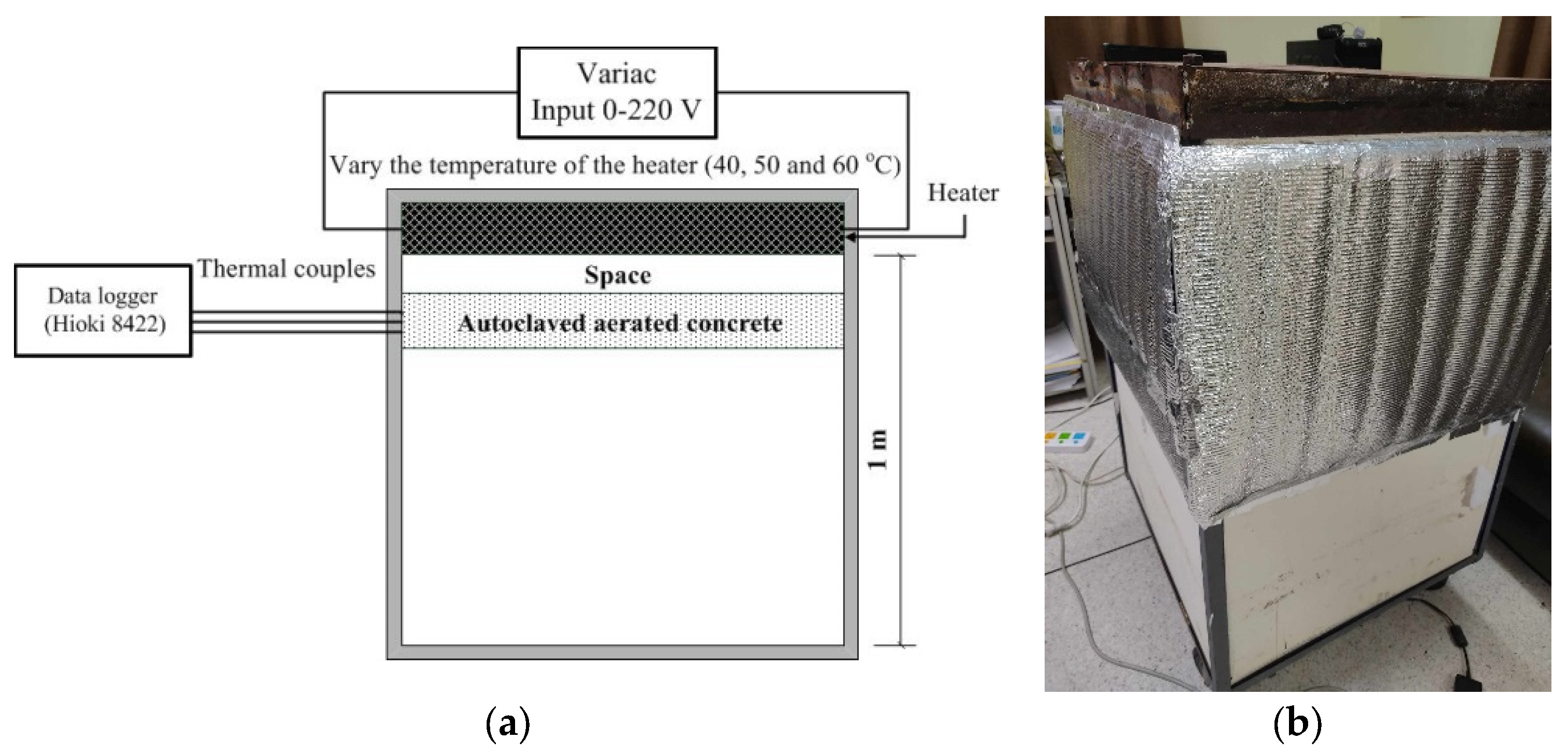


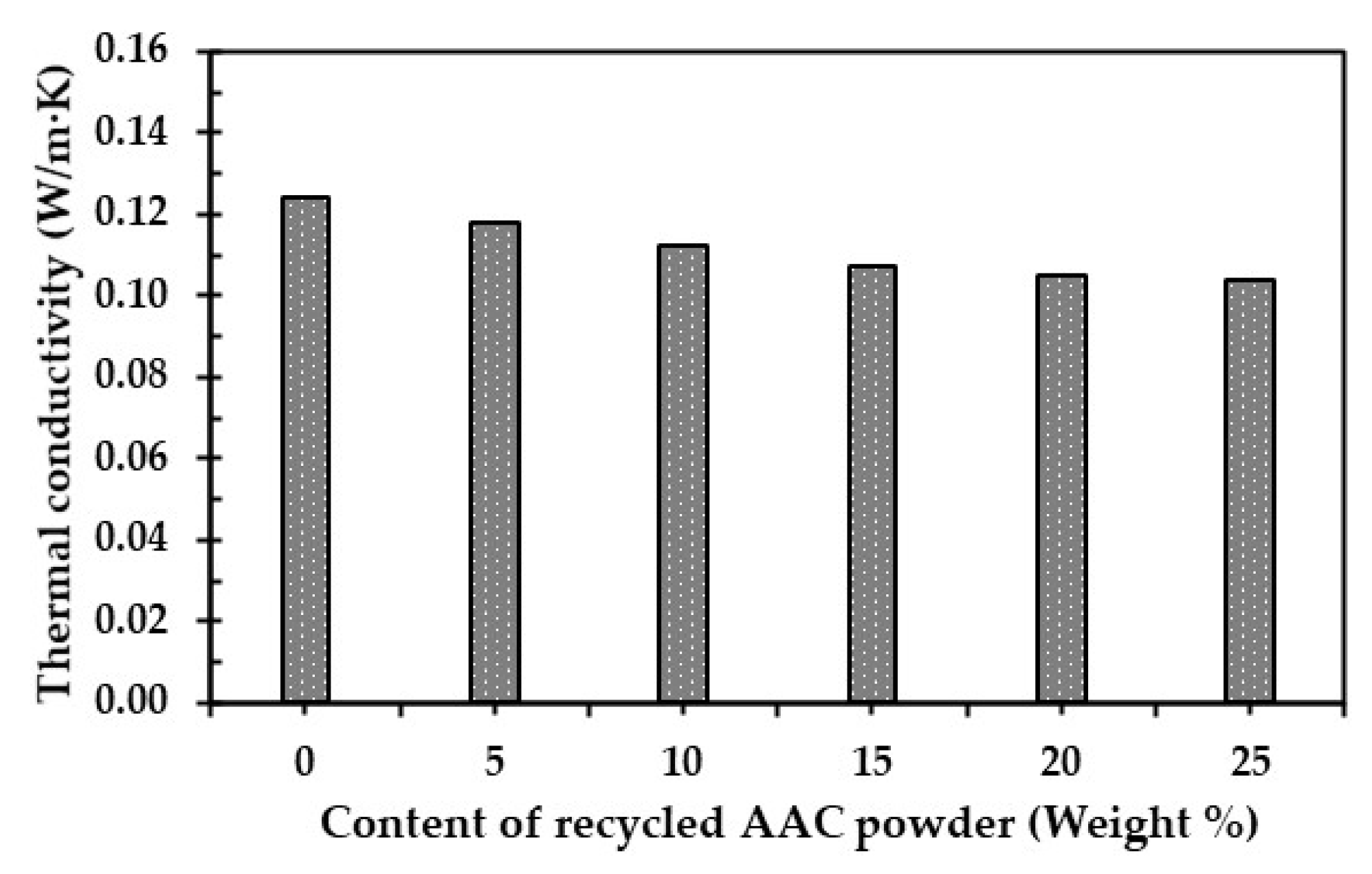
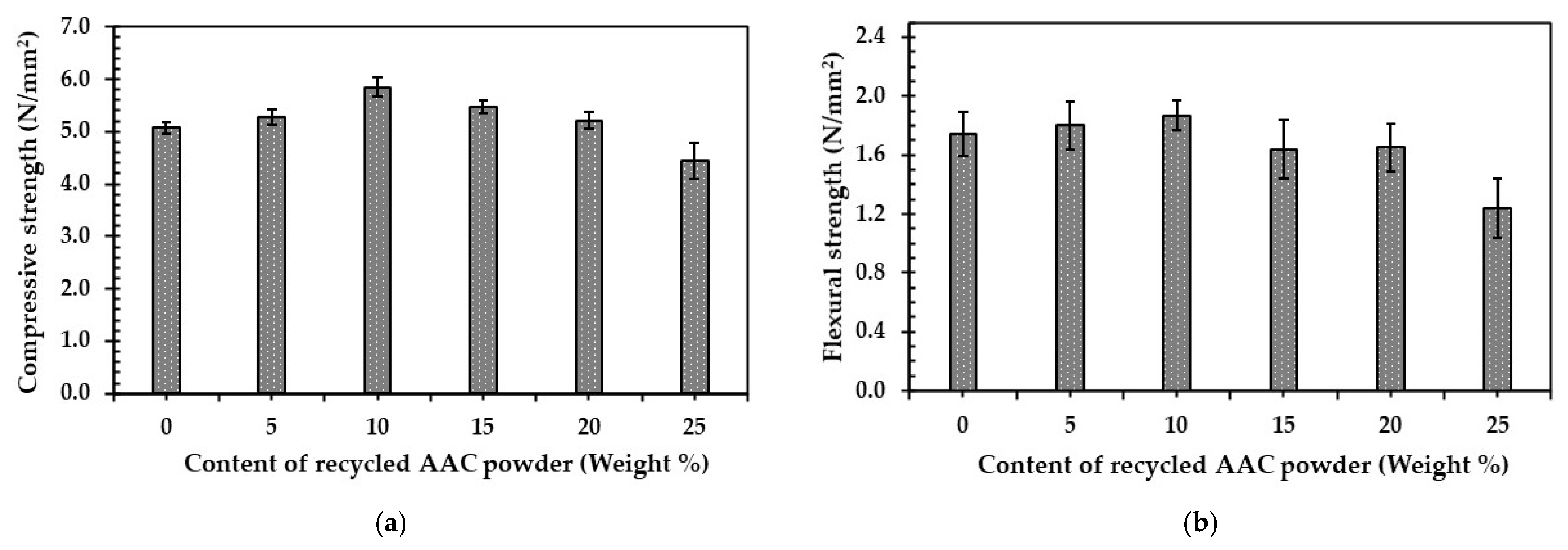
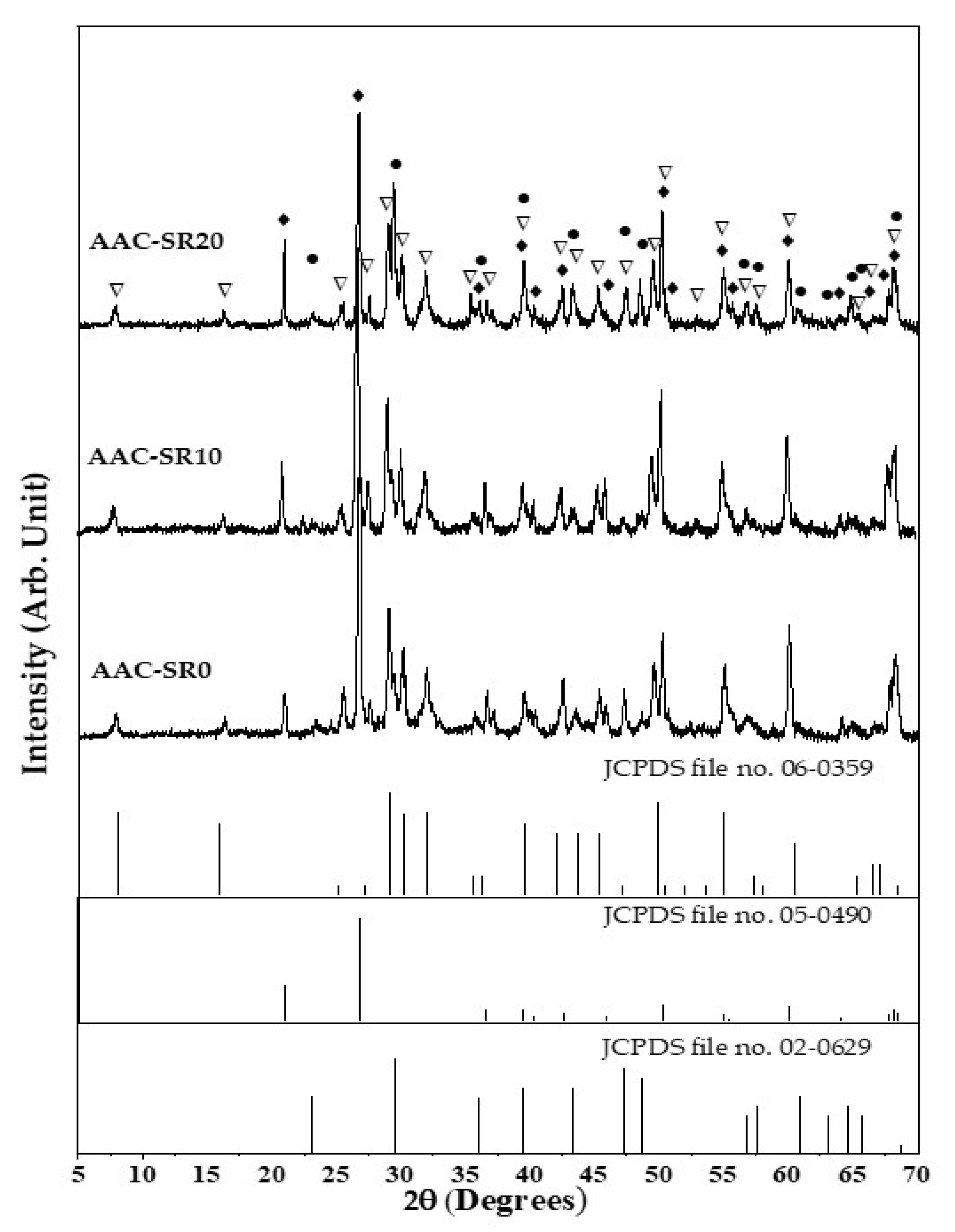
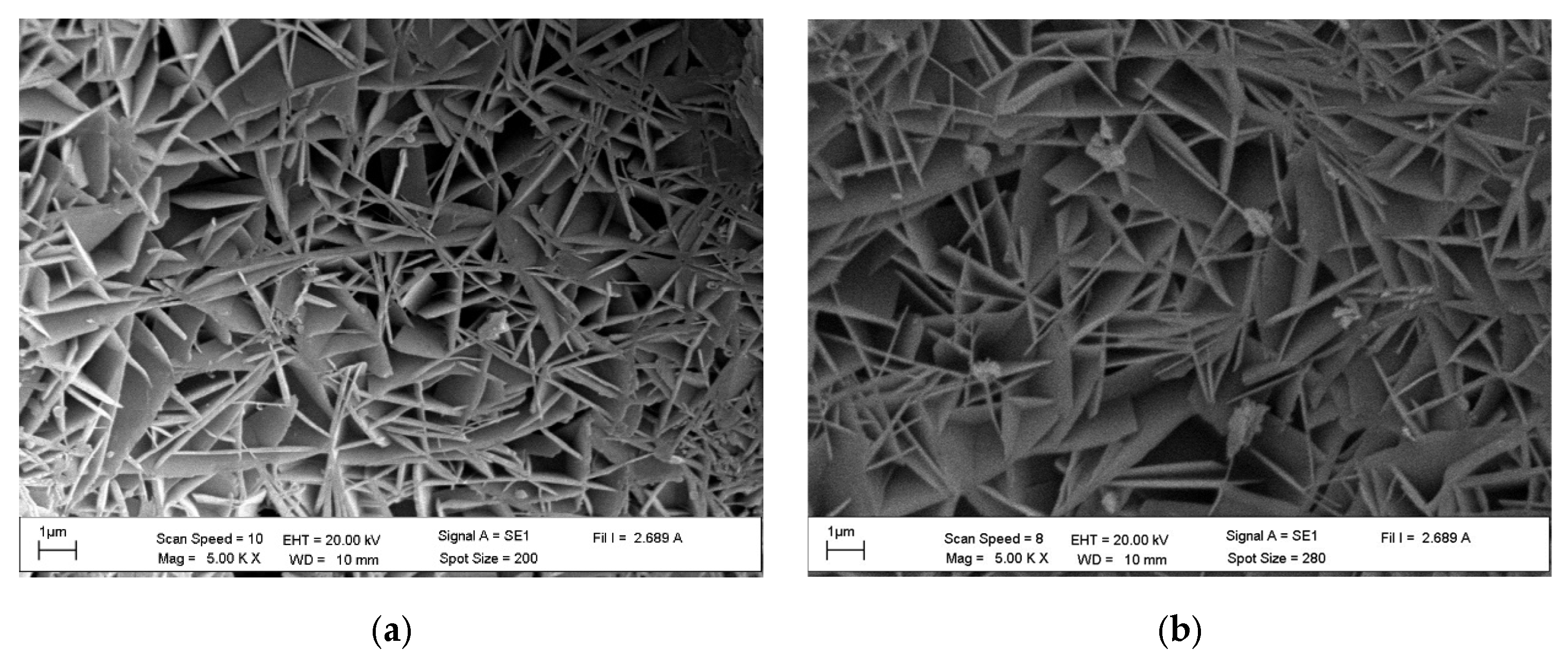


| Composition | Ratio of Phase Formation (%) | ||
|---|---|---|---|
| Calcite | Quartz | Tobermorite | |
| AAC-SR0 | 11.2 | 73.2 | 15.6 |
| AAC-SR10 | 38.1 | 36.4 | 25.5 |
| AAC-SR20 | 32.8 | 45.3 | 21.9 |
| Controlled Temperature (°C) | x (mm) | Average Wall Temperature (°C) | |||
|---|---|---|---|---|---|
| AAC | AAC-P10 | AAC-P20 | AAC-P30 | ||
| 0 | 43.1 | 43.2 | 43.1 | 43.0 | |
| 40 | 25 | 39.8 | 39.2 | 38.6 | 38.5 |
| 50 | 34.6 | 34.3 | 33.9 | 34.0 | |
| 75 | 31.7 | 31.4 | 31.2 | 31.2 | |
| 0 | 50.2 | 50.9 | 51.4 | 52.0 | |
| 50 | 25 | 47.3 | 47.1 | 45.6 | 46.2 |
| 50 | 40.9 | 39.0 | 38.1 | 38.4 | |
| 75 | 33.7 | 33.2 | 32.4 | 32.5 | |
| 0 | 59.7 | 60.7 | 61.2 | 61.0 | |
| 60 | 25 | 53.5 | 52.6 | 51.7 | 51.8 |
| 50 | 45.7 | 44.8 | 43.0 | 43.1 | |
| 75 | 34.8 | 34.2 | 33.5 | 33.4 | |
| Temperature (°C) | x (mm) | Decrement Factor | |||
|---|---|---|---|---|---|
| AAC | AAC-P10 | AAC-P20 | AAC-P30 | ||
| 0 | 0 | 0 | 0 | 0 | |
| 40 | 25 | 0.340 | 0.443 | 0.383 | 0.356 |
| 50 | 0.245 | 0.187 | 0.152 | 0.158 | |
| 75 | 0.132 | 0.184 | 0.084 | 0.089 | |
| 0 | 0 | 0 | 0 | 0 | |
| 50 | 25 | 0.357 | 0.393 | 0.336 | 0.362 |
| 50 | 0.230 | 0.126 | 0.118 | 0.127 | |
| 75 | 0.176 | 0.094 | 0.042 | 0.078 | |
| 0 | 0 | 0 | 0 | 0 | |
| 60 | 25 | 0.382 | 0.362 | 0.387 | 0.395 |
| 50 | 0.241 | 0.213 | 0.108 | 0.127 | |
| 75 | 0.165 | 0.110 | 0.072 | 0.084 | |
| Type of AAC | Time Lag (Φ) at Different Thicknesses (min) | |||
|---|---|---|---|---|
| 0 mm | 25 mm | 50 mm | 75 mm | |
| AAC | 0 | 30 | 68 | 80 |
| AAC-P10 | 0 | 24 | 70 | 92 |
| AAC-P20 | 0 | 20 | 84 | 124 |
| AAC-P30 | 0 | 20 | 80 | 120 |
| Temperature (°C) | Average Room Temperature (°C) | |||
|---|---|---|---|---|
| AAC | AAC-P10 | AAC-P20 | AAC-P30 | |
| 40 | 28.6 | 28.5 | 28.4 | 28.5 |
| 50 | 30.1 | 30.0 | 27.6 | 27.8 |
| 60 | 31.7 | 30.2 | 26.7 | 26.6 |
Disclaimer/Publisher’s Note: The statements, opinions and data contained in all publications are solely those of the individual author(s) and contributor(s) and not of MDPI and/or the editor(s). MDPI and/or the editor(s) disclaim responsibility for any injury to people or property resulting from any ideas, methods, instructions or products referred to in the content. |
© 2023 by the authors. Licensee MDPI, Basel, Switzerland. This article is an open access article distributed under the terms and conditions of the Creative Commons Attribution (CC BY) license (https://creativecommons.org/licenses/by/4.0/).
Share and Cite
Thongtha, A.; Maneewan, S.; Fazlizan, A. Enhancing Thermal Performance of Autoclaved Aerated Concrete (AAC) Incorporating Sugar Sediment Waste and Recycled AAC with Phase Change Material-Coated Applications for Sustainable Energy Conservation in Building. Sustainability 2023, 15, 14226. https://doi.org/10.3390/su151914226
Thongtha A, Maneewan S, Fazlizan A. Enhancing Thermal Performance of Autoclaved Aerated Concrete (AAC) Incorporating Sugar Sediment Waste and Recycled AAC with Phase Change Material-Coated Applications for Sustainable Energy Conservation in Building. Sustainability. 2023; 15(19):14226. https://doi.org/10.3390/su151914226
Chicago/Turabian StyleThongtha, Atthakorn, Somchai Maneewan, and Ahmad Fazlizan. 2023. "Enhancing Thermal Performance of Autoclaved Aerated Concrete (AAC) Incorporating Sugar Sediment Waste and Recycled AAC with Phase Change Material-Coated Applications for Sustainable Energy Conservation in Building" Sustainability 15, no. 19: 14226. https://doi.org/10.3390/su151914226
APA StyleThongtha, A., Maneewan, S., & Fazlizan, A. (2023). Enhancing Thermal Performance of Autoclaved Aerated Concrete (AAC) Incorporating Sugar Sediment Waste and Recycled AAC with Phase Change Material-Coated Applications for Sustainable Energy Conservation in Building. Sustainability, 15(19), 14226. https://doi.org/10.3390/su151914226










